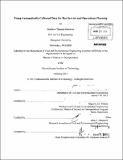Using automatically collected data for bus service and operations planning
Author(s)
Shireman, Matthew Thomas
DownloadFull printable version (25.45Mb)
Other Contributors
Massachusetts Institute of Technology. Dept. of Civil and Environmental Engineering.
Advisor
Nigel H. M. Wilson and John P. Attanucci.
Terms of use
Metadata
Show full item recordAbstract
Transit agencies have traditionally used manual data to measure performance and plan service, but many transit agencies now fulfill these tasks by using automated data collection systems (ADCS), including Automatic Vehicle Location (AVL), Automatic Passenger Counters (APC), and Automated Fare Collection (AFC) systems. ADCS enable service planners to make more informed decisions due to the larger, more ubiquitous, and timelier sets of performance data. This thesis evaluates current MBTA bus service in Somerville and Medford using several types of ADCS-based performance indicators. Route profiles are developed for each route in the study area and demand is analyzed for each route and its segments. Archived AVL running times are analyzed and recommendations are produced to improve reliability by adjusting the current scheduled running times where appropriate. This thesis evaluates several service planning scenarios using GIRO Inc.'s NetPlan software package, which is a sketch service planning and timetabling tool linked to its HASTUS automated scheduling system. The outputs of the ridership and running time analyses are used as inputs into bus service scenario planning process. The service change scenarios include implementing even, clock-face headways, utilizing interlining, improving the scheduled running times and layover times, modifying frequencies based on demand, synchronizing routes that serve the same route segments, and incorporating selected changes in routing. The number of buses required to serve each timetable scenario is the primary output of interest. This thesis finds that automated sketch service planning tools, such as NetPlan, can improve the efficiency of timetables by performing thousands of iterations that would otherwise be impractical. In the resource-constrained AM peak, timetabling inefficiencies in the existing schedule were reduced to improve reliability, increase frequencies, and modify routings. The peak period service frequency changes resulted in an expected net passenger wait time and scheduled delay savings of 165 hours. For the most comprehensive timetabling scenarios, interlining was found in 72 percent of the optimized vehicle blocks indicating that transit agencies can create timetables that use highly reliable cycle times and equitable headways based on current route ridership and cost considerations.
Description
Thesis (S.M. in Transportation)--Massachusetts Institute of Technology, Dept. of Civil and Environmental Engineering, 2011. Cataloged from PDF version of thesis. Includes bibliographical references (p. 199-201).
Date issued
2011Department
Massachusetts Institute of Technology. Department of Civil and Environmental EngineeringPublisher
Massachusetts Institute of Technology
Keywords
Civil and Environmental Engineering.